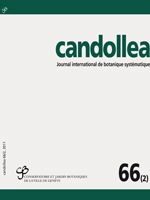Introduction
Memecylon L. (Melastomataceae) is widely distributed in the Old World tropics and consists of more than 300 species of generally small trees or shrubs, most of them occurring in the understory of evergreen forest (Renner & al., 2007–2011). For Madagascar, the most recent treatment of the genus recognized 78 species (Jacques-Félix, 1985a , 1985b), and much of the recently collected material appears to represent species new to science (Stone, 2006). Pending completion of a comprehensive taxonomic revision of Malagasy Memecylon, the purpose of this note is to propose new combinations at species rank for the taxa originally described as M. pedunculatum var. centrale Jacq.-Fél. and M. eglandulosum var. bezavonense Jacq.-Fél. A lectotype is also designated for the latter. Each species is provided with observations and conservation status using the current IUCN Red List Criteria (2001).
Taxonomy and nomenclature
Memecylon centrale (Jacq.-Fél.) R. D. Stone, stat. nov.
≡ Memecylon pedunculatum var. centrale Jacq.-Fél. in Bull. Mus. Natl. Hist. Nat., B, Adansonia 6: 451. 1985.
Typus: MADAGASCAR. Prov. Antananarivo: massif d'Anorimbato, à l'Ouest d'Ambaravaranala (Tsiroanomandidy), aux confins de la haute Mahavavy et de la haute Bebao, [18°26′S 45°37′E], 15–16.V.1970, fr., Service Forestier 29170 (holo-: P [P00062672]!; iso-: K [K000 313587]!, MO [MO-313781, MO-313782]!, P [P00062673, P00062674]!, TEF [TEF000321]!).
Conservation status. — With an AOO of 18 km2 and 2 subpopulations, neither of which are situated within the protected area network, M. centrale is assigned a preliminary status of Endangered (EN B2ab[iii]) following the IUCN Red List Categories and Criteria (IUCN, 2001) (calculation following Callmander & al., 2007).
Observations. — Memecylon centrale appears to be a narrow endemic of forest vestiges in the Bongolava mountains, situated along the western edge of Madagascar's Central Plateau. It shares with M. pedunculatum Jacq.-Fél. the character of young branchlets with brownish-black bark soon exfoliating in strips to reveal whitish inner bark, as well as the character of the fruit, which is sessile above the peduncle. Its leaves however are narrowly lanceolate (dimensions 3.3–4.4 × 0.9–1.2 cm) and weakly acuminate at the apex, while in M. pedunculatum the leaves are ovate-lanceolate (dimensions 4.3–6.1 × 1.3–2.4 cm) and distinctly caudate-acuminate (the acumen linear, c. 1.5 cm long). Furthermore, the area inhabited by M. centrale is separated by c. 600 km from the region where M. pedunculatum occurs, in and around Marojejy National Park in northeastern Madagascar (Antsiranana Province). Species status for M. centrale is justified by its geographic isolation from M. pedunculatum and the evident lack of morphological intermediates between these taxa.
Additional specimens. — Madagascar. Prov. Antananarivo: Tsiroanomandidy, Ambaravaranala, 18°25′S 45°40′E, alt. 1190–1200 m, forêt sur pente et forêt galerie, 25.VI.1997, fr., Rakotomalaza & al. 1356 (CAS, MO, P, TAN).
Memecylon bezavonense (Jacq.-Fél.) R. D. Stone, stat. nov.
≡ Memecylon eglandulosum var. bezavonense Jacq.-Fél. in Bull. Mus. Natl. Hist. Nat., B, Adansonia 7: 10. 1985.
Lectotypus (designated here): MADAGASCAR. Prov. Antsiranana: massif du Bezavona (entre la Fanambana et la Manambery), pentes inférieures de la rive droite de l'Andilana, [13°32′S 49°54′E], 20.III.1967, fl., Service Forestier 27546 (P [P00057775]!; isolecto-: P [P00057 776]!, MO [MO-345892, MO-391665]!, TEF!).
Conservation status. — With an EOO of > 100 km2, an AOO of 18 km2 and 2 subpopulations, neither of which are situated within the protected area network, M. bezavonense is assigned a preliminary status of Endangered (EN B1ab[iii]; B2ab[iii]) following the IUCN Red List Categories and Criteria (IUCN, 2001) (calculation following Callmander & al., 2007).
Observations. — This species is evidently restricted to dry, semi-deciduous forests in northeastern Madagascar. Its des cription as a variety of M. eglandulosum H. Perrier was seemingly based on floral characters, which were said to be identical between the two taxa (Jacques-Félix, 1985b: 12). Additional collections have revealed that the fruits of M. bezavonense are characteristically asymmetrical and have a distinct calycinal crown, quite unlike the fruits of M. eglandulosum which are larger, globose and have a stylopodium projecting past the truncate rim of the calyx (Fig. 1). Species status for M. bezavonense is further justified by its smaller, oblanceolate leaves (dimensions 4–5 × 1.2–1.8 cm) in comparison to the larger, ± elliptic leaves of M. eglandulosum (dimensions 5–7.5 × 2–3 cm).
Additional specimens. — Madagascar. Prov. Antsiranana: type loc., 13.XII.1966, st., Service Forestier 27239-bis (P, TEF); Antsiranana II, Andrafiabe, Saharenana, lieu de récolte Andranomadio-Sahafary, 3 km au Sud-Est du village de Saharenana, 12°36′26″S 49°26′21″E, alt. 227 m, forêt sèche semicaducifoliée, 10.XI.2004, fr., Rakotondrajaona & al. 342 (CAS, MO, P, TAN). S. loc.: s.d., fr., Service Forestier 29413 (TEF).
Acknowledgements
Support from the California Academy of Sciences (John J. Rose Postdoctoral Fellowship) is gratefully acknowledged. Curators of the following herbaria are thanked for allowing access to specimens: BR, G, K, MO, P, TEF.







